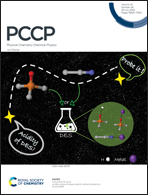Nature of excited-state dependent hydrogen bonds and their critical role in determining the photophysical properties of aromatic thioketones†
Abstract
In this work, how the excited-state dependent hydrogen bond (H-bond) interactions control photophysical processes have been uncovered by accurate electronic structure calculations for the five lowest-lying states (S0, S1, S2, T1, and T2) of three aromatic thioketones and their isomers. The difference in the H-bond nature between S2 and S1 gives rise to ultrafast S2 → S1 internal conversion via the two-state conical intersection. Strong S2 fluorescence observed usually in thiocarbonyl compounds is absent in aromatic thioketones with intramolecular H-bonds. Meanwhile, the relatively weak H-bond interactions in S1 and T1 states make the S1, T2, and T1 states degenerate or quasi-degenerate. As a result, the T2 state acts as a relay and enables both forward S1 → T1 and reverse T1 → S1 processes to occur efficiently, which provides new insights into the mechanism of thermally activated delayed fluorescence (TADF), and could be used to improve the design principle of purely organic TADF materials.

- This article is part of the themed collection: 2022 PCCP HOT Articles


 Please wait while we load your content...
Please wait while we load your content...